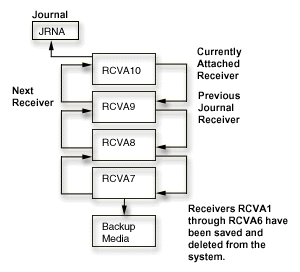Journal receivers that are associated with a journal (that is presently or previously attached to the journal) are linked in one or more receiver chains. Each journal receiver, except the first one, has a previous receiver that was detached when the current receiver was attached. Each journal receiver, except the one that is currently attached, also has a next receiver.
The following figure illustrates the process by which journal receiver chains are created. If you leave the previously attached receivers RCVA7 through RCVA9 online, you can use them to apply changes, to remove changes, or to display journal entries without restoring them first.
Journal receiver chain

 The figure above represents a journal receiver chain. It shows
four journal receivers for journal JRNA. Journal receivers RCVA7, RCVA8, and
RCVA9 are online. Journal receiver RCVA10 is currently attached to journal
JRNA. Journal receivers RCVA1 through RCVA6 are saved to backup media and
not are not on the system.
The figure above represents a journal receiver chain. It shows
four journal receivers for journal JRNA. Journal receivers RCVA7, RCVA8, and
RCVA9 are online. Journal receiver RCVA10 is currently attached to journal
JRNA. Journal receivers RCVA1 through RCVA6 are saved to backup media and
not are not on the system.
If a complete copy of a receiver is missing in a chain of journal receivers linked together in the previously described relationship, the result is a chain break. Avoid receiver chain breaks. A receiver chain break indicates that any changes made between the last entry in the last receiver in one chain and the first entry in the first receiver in the next chain are not available in any journal receiver on the system.
Using a save-while-active operation to save objects before they reach a commitment boundary can result in objects saved to the media that have partial transactions. A break in a journal receiver chain can prevent you from recovering these objects with partial transactions.
A set of receivers for a journal that has one or more receiver chain breaks has multiple receiver chains. Receiver chain breaks result from the following:
- You restored an old journal receiver and its next receiver is not on the system.
- A journal receiver was saved while it was attached, a partial receiver is restored, and no complete copy of the receiver is on the system or restored.
- A receiver that has not had its storage freed by a save operation is restored, and the next receiver has had its storage freed by a save operation.
- The journal is restored. All journal receivers associated with the previous copy of the journal (before the journal was deleted and restored) will not be in the same receiver chain as the currently attached journal receiver.
- The user or the system deleted a damaged or destroyed journal receiver from the middle of a chain.
- A journal receiver from another system is restored. The journal receiver will be associated with a journal at restore time if the associated library and journal on the source system had the same library name and journal name as the library and journal on the target system.
- You chose to replicate specific receivers instead of all receivers in the receiver directory chain. This occurred while replicating journal receivers from a source system to a target system.
You cannot use the following commands and API across multiple receiver chains:
- Apply Journaled Changes (APYJRNCHG) command
- Apply Journaled Changes Extend (APYJRNCHGX) command
- Remove Journaled Changes (RMVJRNCHG) command
- Receive Journal Entries (RCVJRNE) command
- Display Journal (DSPJRN) command
- Retrieve Journal Entries (RTVJRNE) command
- Compare Journal Images CMPJRNIMG command
- Retrieve Journal Entries (QjoRetrieveJournalEntries) API
If multiple receiver chains exist, you need to determine:
- Whether any journal entries are missing.
- Whether your data will be valid if you use more than one receiver chain.
If you decide to proceed, you must run a separate command for each receiver chain.
You can use the Work with Journal Attributes (WRKJRNA) command to display the receiver chain (F15) and work with journal receivers. See Display information for journaled objects, journals, and receivers for more information about the WRKJRNA command.
See the Save your server while it is active link below for instructions for saving an object with transactions in a partial state. See the Example: Recover objects with partial transactions link for instructions for recovering objects with transactions in a partial state.